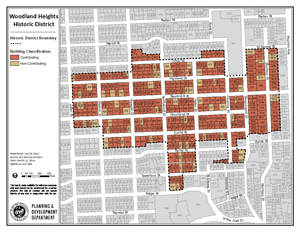

Woodland Heights
About
Woodland Heights is a subdivision in the greater Heights area, north of downtown Houston. The William Wilson Realty Company established Woodland Heights in 1907. It was designed to be upscale, yet affordable for middle class families. Most of the houses were built in the Queen Anne, Craftsman, and American Four Square styles. In the 1960s and 1970s, many new suburbs were built around Houston. As people moved out of Woodland Heights, the neighborhood declined. It began to turn around in the 1980s, thanks to residents’ hard work and commitment. Today, many homes in the Woodland Heights Historic District look the way they did in 1907.
Woodland Heights is located on 106 acres of rich, sandy soil north of White Oak Bayou. The neighborhood was platted by William A. Wilson. During the early 1900s, Wilson was one of Houston’s leading developers; his company built an average of two houses per week. Wilson also planted many trees around Houston and he was responsible for the stately live oak trees that still line Bayland Avenue today.
Woodland Heights was marketed as a modern development. Woodland Heights had a modern water system while most homes elsewhere still collected water in cisterns. The neighborhood had electricity, gas, and telephone lines. It also had electric street lights and fire hydrants. Wilson published a magazine called “Woodland Heights” that included photographs and floor plans of houses. The magazine described streets lined with trees and “miles of the finest cement sidewalks.”
Woodland Heights also had deed restrictions – rules about what could be built and how – that defined the look and feel of the neighborhood. No commercial businesses were allowed. No alcohol could be sold within the subdivision. The deed restrictions also required a generous setback, creating consistently large front yards with plenty of room for grass, trees, and flowers. It was quiet and spacious, and residents could easily commute back and forth on the electric streetcar line. As it developed, Woodland Heights was a popular place to live for those who worked downtown but wanted to live away from the noise and the crowds.
The neighborhood began to lose its appeal in the 1960s. The original deed restrictions lapsed at some point leaving the neighborhood without rules to protect its appearance. Then the I-610 Loop was built around Houston, and the city expanded rapidly. Many residents left Woodland Heights for the new outer suburbs. The neighborhood declined until the 1980s, when a group of determined homeowners began working to revitalize it. When a state law was passed in 1988 that allowed neighborhoods to reinstate lapsed deed restrictions, Woodland Heights residents reinstated deed restrictions and Minimum Building Line (MBL) ordinances, which regulate front setback, and lot size ordinances. Those deed restrictions and ordinances affect various sections of Woodland Heights. For more information or to find out if your property, please contact the Woodland Heights Civic Association.